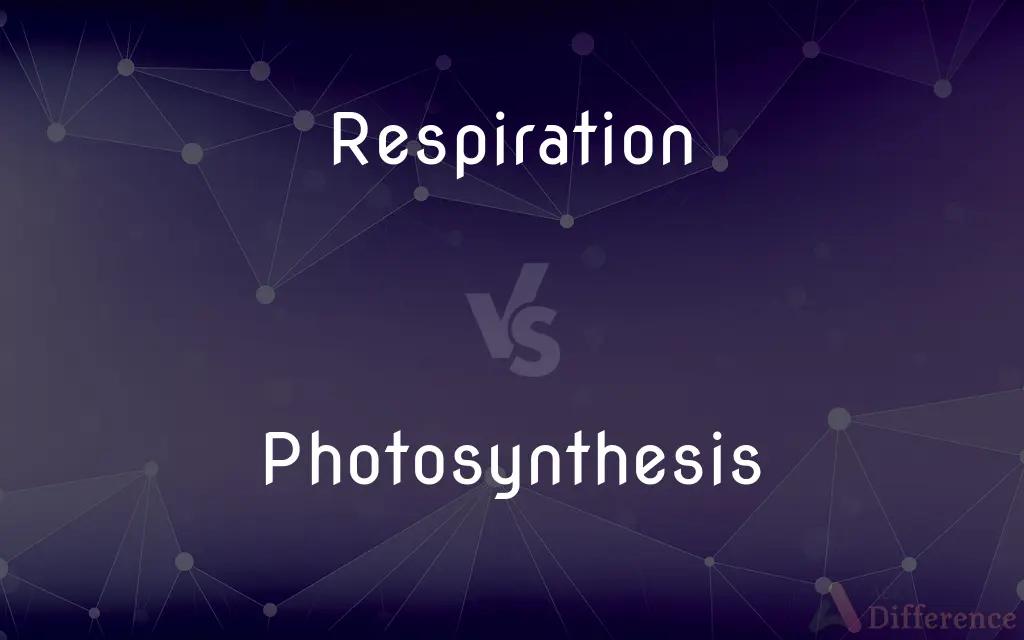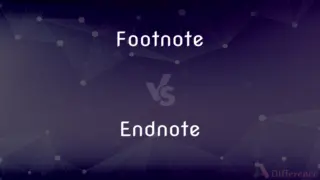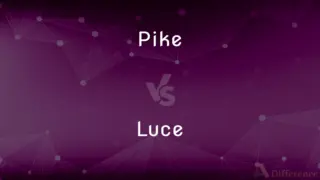Respiration vs. Photosynthesis — What's the Difference?
By Fiza Rafique & Maham Liaqat — Updated on April 17, 2024
Respiration is a process used by all living organisms to convert glucose into energy, whereas photosynthesis is a process used by plants and some bacteria to convert light energy into glucose.

Difference Between Respiration and Photosynthesis
Table of Contents
ADVERTISEMENT
Key Differences
Respiration involves the breakdown of glucose to release energy, which is necessary for cellular functions, while photosynthesis is the process by which plants, algae, and some bacteria convert light energy into chemical energy stored in glucose.
In respiration, oxygen is consumed and carbon dioxide is released as a byproduct, whereas in photosynthesis, carbon dioxide is consumed and oxygen is released, making these processes complementary in the Earth's ecosystem.
Photosynthesis occurs in the chloroplasts of plant cells and involves two main stages: the light-dependent reactions and the Calvin cycle, while respiration takes place in the mitochondria and includes glycolysis, the Krebs cycle, and the electron transport chain.
The primary function of photosynthesis is to produce glucose and store energy, providing the base for most food chains, while respiration is essential for extracting this energy from glucose to power cellular activities.
While photosynthesis is restricted to plants and some bacteria that have chlorophyll and access to light, respiration occurs in nearly all living organisms, including plants, animals, fungi, and other bacteria, reflecting its fundamental role in life.
ADVERTISEMENT
Comparison Chart
Purpose
Converts glucose into usable energy (ATP)
Converts light energy into glucose
Occurs in
All living organisms
Plants, algae, and some bacteria
Cellular Location
Mitochondria
Chloroplasts
Stages
Glycolysis, Krebs cycle, Electron transport chain
Light-dependent reactions, Calvin cycle
Gas Exchange
Consumes O2, releases CO2
Consumes CO2, releases O2
Compare with Definitions
Respiration
Involves the breakdown of glucose to produce ATP.
Cellular respiration in muscle cells provides the energy needed for contraction.
Photosynthesis
Produces oxygen as a byproduct.
Forests are considered the lungs of the planet because they release large amounts of oxygen through photosynthesis.
Respiration
The process by which cells obtain energy by consuming oxygen and releasing carbon dioxide.
Humans perform respiration by breathing in oxygen and exhaling carbon dioxide.
Photosynthesis
Divided into light-dependent reactions and the Calvin cycle.
The Calvin cycle uses ATP and NADPH produced in light reactions to make glucose.
Respiration
Occurs in mitochondria of cells.
Mitochondria are often called the powerhouse of the cell because they are the site of respiration.
Photosynthesis
The process by which green plants use sunlight to synthesize foods from carbon dioxide and water.
Leaves are green because chlorophyll in chloroplasts is involved in photosynthesis.
Respiration
Consists of multiple stages, including glycolysis and the Krebs cycle.
During intense exercise, cells rapidly perform glycolysis to meet energy demands.
Photosynthesis
Key to energy and food production in ecosystems.
All food chains start with photosynthetic organisms as the primary producers.
Respiration
Necessary for sustaining life in animals and plants.
Even plants respire, especially at night when photosynthesis ceases.
Photosynthesis
Involves capturing energy from sunlight.
Photosynthetic organisms capture light energy using pigments like chlorophyll.
Respiration
The action or process of inhaling and exhaling; breathing. Also called ventilation.
Photosynthesis
Photosynthesis is a process used by plants and other organisms to convert light energy into chemical energy that, through cellular respiration, can later be released to fuel the organism's metabolic activities. This chemical energy is stored in carbohydrate molecules, such as sugars and starches, which are synthesized from carbon dioxide and water – hence the name photosynthesis, from the Greek phōs (φῶς), "light", and sunthesis (σύνθεσις), "putting together".
Respiration
An act of inhaling and exhaling; a breath.
Photosynthesis
The process in green plants and certain other organisms by which carbohydrates are synthesized from carbon dioxide and a source of hydrogen (usually water), using light as an energy source. Most forms of photosynthesis release oxygen as a byproduct.
Respiration
The action or process by which an organism without lungs, such as a fish or plant, exchanges gases with its environment.
Photosynthesis
(biology) Any process by which plants and other photoautotrophs convert light energy into chemical energy,
Respiration
The oxidative process occurring within living cells by which the chemical energy of organic molecules is converted in a series of metabolic steps into usable energy in the form of ATP, involving the consumption of oxygen and the production of carbon dioxide and water as byproducts.
Photosynthesis
Principally, oxygenic photosynthesis, any process by which plants and algae convert water and carbon dioxide into carbohydrates and waste oxygen using solar energy.
Respiration
Any of various analogous metabolic processes by which certain organisms, such as anaerobic bacteria and some fungi, obtain energy from organic molecules without consuming oxygen.
Photosynthesis
Also, non-oxygenic photosynthesis, used by purple and green bacteria, heliobacteria, and acidobacteria.
Respiration
The process of inhaling and exhaling; breathing, breath.
Photosynthesis
The process of constructive metabolism by which carbohydrates are formed from water vapor and the carbon dioxide of the air in the chlorophyll-containing tissues of plants exposed to the action of light. It was formerly called assimilation, but this is now commonly used as in animal physiology. The details of the process are not yet clearly known. Baeyer's theory is that the carbon dioxide is reduced to carbon monoxide, which, uniting with the hydrogen of the water in the cell, produces formaldehyde, the latter forming various sugars through polymerization. Vines suggests that the carbohydrates are secretion products of the chloroplasts, derived from decomposition of previously formed proteids. The food substances are usually quickly translocated, those that accumulate being changed to starch, which appears in the cells almost simultaneously with the sugars. The chloroplasts perform photosynthesis only in light and within a certain range of temperature, varying according to climate. This is the only way in which a plant is able to organize carbohydrates. All plants without a chlorophyll apparatus, as the fungi, must be parasitic or saprophytic.
Respiration
An act of breathing; a breath.
Photosynthesis
Synthesis of compounds with the aid of radiant energy (especially in plants)
Respiration
Any similar process in an organism that lacks lungs that exchanges gases with its environment.
Respiration
The process by which cells obtain chemical energy by the consumption of oxygen and the release of carbon dioxide.
Respiration
The act of respiring or breathing again, or catching one's breath.
Respiration
Relief from toil or suffering: rest.
Till the dayAppear of respiration to the justAnd vengeance to the wicked.
Respiration
Interval; intermission.
Respiration
The act of resping or breathing; the act of taking in and giving out air; the aggregate of those processes bu which oxygen is introduced into the system, and carbon dioxide, or carbonic acid, removed.
Respiration
A single complete act of breathing in and out;
Thirty respirations per minute
Respiration
The bodily process of inhalation and exhalation; the process of taking in oxygen from inhaled air and releasing carbon dioxide by exhalation
Common Curiosities
How does light affect photosynthesis?
Light is crucial for photosynthesis as it provides the energy needed to convert CO2 and water into glucose and oxygen.
What are the byproducts of respiration and photosynthesis?
The byproduct of respiration is mainly carbon dioxide, while photosynthesis primarily produces oxygen.
What is the main difference between respiration and photosynthesis?
The main difference is that respiration breaks down glucose to release energy, while photosynthesis uses light energy to create glucose.
Why are both respiration and photosynthesis important for the environment?
They are vital for the carbon and oxygen cycles, with photosynthesis providing oxygen and organic compounds and respiration using these compounds and releasing CO2.
Where do the processes of respiration and photosynthesis take place in a cell?
Respiration occurs in the mitochondria, while photosynthesis takes place in the chloroplasts.
What role does chlorophyll play in photosynthesis?
Chlorophyll captures solar energy and converts it into chemical energy during photosynthesis.
What happens during the Calvin cycle?
In the Calvin cycle, ATP and NADPH from light-dependent reactions are used to convert CO2 into glucose.
Can photosynthesis occur without light?
Photosynthesis requires light for the light-dependent reactions, so it cannot occur without light.
What is the significance of the electron transport chain in respiration?
The electron transport chain produces the majority of ATP during cellular respiration by transferring electrons and pumping protons to generate a gradient used to synthesize ATP.
What adaptations help plants optimize photosynthesis?
Plants have adaptations like leaf orientation, stomatal control, and specialized photosynthetic pathways to optimize energy capture and use.
Can plants perform both photosynthesis and respiration?
Yes, plants perform both processes; they photosynthesize to create glucose and respire to break it down for energy.
Why is ATP important for cells?
ATP is the primary energy currency of the cell, used to power various biological processes.
Is respiration considered a form of combustion?
Respiration is sometimes likened to a slow, controlled form of combustion as it involves the breakdown of organic molecules with the release of energy, CO2, and water.
How do respiration and photosynthesis complement each other?
Photosynthesis produces the glucose and oxygen necessary for respiration, and respiration produces the CO2 and ATP needed for photosynthesis.
How do temperature and CO2 levels affect photosynthesis?
Higher temperatures can increase the rate of photosynthesis up to a point, while increased CO2 levels typically enhance photosynthesis.
Share Your Discovery

Previous Comparison
Footnote vs. Endnote
Next Comparison
Pike vs. LuceAuthor Spotlight
Written by
Fiza RafiqueFiza Rafique is a skilled content writer at AskDifference.com, where she meticulously refines and enhances written pieces. Drawing from her vast editorial expertise, Fiza ensures clarity, accuracy, and precision in every article. Passionate about language, she continually seeks to elevate the quality of content for readers worldwide.
Co-written by
Maham Liaqat













































